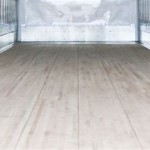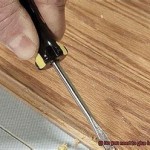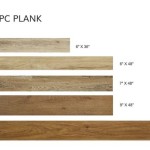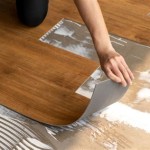Does Vinyl Flooring Look Like Wood? A Detailed Examination
Vinyl flooring has rapidly evolved in recent years, becoming a popular alternative to traditional hardwood. One of the primary reasons for this upsurge is its ability to convincingly mimic the appearance of wood. This article aims to explore the extent to which vinyl flooring replicates the look of real wood, considering various factors like manufacturing techniques, visual characteristics, and installation practices.
The desire for wood-look flooring stems from the inherent aesthetic appeal of natural wood. Wood flooring offers warmth, character, and a timeless elegance that can enhance the ambiance of any living space. However, real wood comes with certain drawbacks, including susceptibility to moisture damage, higher installation costs, and ongoing maintenance requirements. Vinyl flooring seeks to address these shortcomings while retaining the visual advantages of wood.
Developments in Manufacturing Technology
The authenticity of wood-look vinyl flooring is directly linked to advancements in manufacturing technology. Early vinyl flooring options often presented a two-dimensional, repetitive pattern that was easy to distinguish from genuine wood. Modern techniques, however, have significantly improved the realism of these products.
One key innovation is the use of high-resolution printing. Manufacturers now employ sophisticated printing equipment to create highly detailed images of various wood species, capturing the intricate grain patterns, knots, and color variations found in natural timber. These images are then transferred onto the vinyl surface with remarkable clarity and precision.
Another significant improvement is the incorporation of embossed textures. Embossing creates a three-dimensional surface that closely mimics the feel of real wood. This technique allows the vinyl to have a tactile texture that corresponds with the printed image, further enhancing the illusion of genuine wood. For instance, vinyl flooring designed to resemble oak might feature an embossed grain pattern that meticulously follows the printed wood grain, making it visually and tactilely similar to actual oak.
Furthermore, wear layers have been improved. The wear layer is a transparent, protective coating applied to the surface of the vinyl flooring. A thicker, more durable wear layer not only protects the flooring from scratches and scuffs but also helps to preserve the realism of the wood-look design. Advanced wear layers can also incorporate subtle textures that further contribute to the overall authenticity.
Beyond individual planks and tiles, manufacturing techniques now allow for more varied patterns within a single batch. Earlier vinyl flooring sometimes suffered from noticeable repetition, making the "fake" look more apparent. Modern production methods minimize repetition and introduce more variation, creating a more natural and less predictable aesthetic.
Visual Characteristics: Evaluating the Realism
Several visual characteristics contribute to the overall realism of wood-look vinyl flooring. These factors should be carefully considered when evaluating different vinyl options and comparing them to real wood.
Color variation is a critical aspect. Natural wood exhibits a range of color variations, even within the same species. High-quality vinyl flooring will replicate this variation, incorporating lighter and darker tones to create a more authentic and dynamic appearance. Consistent, uniform color throughout the flooring is a clear indicator of a less realistic vinyl product.
Grain patterns are another important consideration. The grain pattern of wood is unique and intricate, with varying widths, depths, and directions. Vinyl flooring that accurately reproduces these patterns will appear more natural. Look for vinyl options that feature detailed and irregular grain patterns, avoiding those with simple or repetitive designs.
The presence of knots and imperfections is also crucial. Natural wood often contains knots, cracks, and other imperfections that add character and visual interest. Vinyl flooring that incorporates these features will appear more realistic. However, the inclusion of these imperfections should be done tastefully and in proportion to the overall design, avoiding an overly cluttered or artificial appearance.
The edge design of the vinyl planks or tiles also plays a role. Beveled edges, for example, create a more defined separation between the planks, mimicking the look of real wood flooring where individual planks are slightly offset. Square edges, on the other hand, can create a more seamless appearance, which may be desirable in some instances but can also detract from the overall realism.
The finish of the vinyl flooring also significantly impacts its appearance. Matte finishes tend to look more realistic than high-gloss finishes, as they mimic the natural sheen of wood. A matte finish also helps to conceal imperfections and scratches, contributing to the long-term visual appeal of the flooring.
Installation Techniques and Their Impact
Even high-quality wood-look vinyl flooring can appear less realistic if it is not installed properly. The installation process can significantly impact the final appearance and overall illusion of real wood.
Subfloor preparation is paramount. A smooth, level and clean subfloor is essential for ensuring that the vinyl flooring lays flat and looks its best. Any imperfections in the subfloor will telegraph through the vinyl, compromising its appearance. Uneven floors can also lead to premature wear and tear.
Staggering the planks or tiles is crucial for achieving a natural look. Avoid creating a uniform pattern by staggering the end joints of the planks or tiles in a random or semi-random fashion. This helps to eliminate the appearance of repetition and creates a more organic and visually appealing installation.
Proper spacing between planks is also important. While some vinyl flooring options are designed for tight, seamless installations, others may benefit from slight spacing to mimic the natural expansion and contraction of wood. Consult the manufacturer's instructions for specific spacing recommendations.
The use of transition strips can also affect the overall appearance. While transition strips are necessary to bridge gaps between different types of flooring or to accommodate elevation changes, they should be chosen carefully to complement the vinyl flooring and minimize their visual impact. Matching the color and style of the transition strip to the vinyl flooring can help to create a more cohesive and seamless look.
Finally, professional installation can make a significant difference. While some homeowners may choose to install vinyl flooring themselves, professional installers have the experience and expertise to ensure that the flooring is installed correctly and that all details are addressed to maximize its realism. Professional installers can also provide valuable advice on subfloor preparation, plank layout, and other important considerations.
In conclusion, the extent to which vinyl flooring looks like wood depends on a combination of factors, including advancements in manufacturing technology, the visual characteristics of the flooring itself, and the quality of the installation. By carefully considering these factors, consumers can select vinyl flooring options that effectively mimic the appearance of real wood and enhance the aesthetic appeal of their homes.
Vinyl Flooring That Looks Like Wood

Vinyl Flooring That Looks Like Wood Top Picks 2024 Panel Town Floors
Vinyl Flooring That Looks Like Wood
Vinyl Flooring That Looks Like Wood

How To Tell If Your Floor Is Hardwood Or Vinyl Garrison Collection

Vinyl Flooring That Looks Like Wood Lx Hausys
Vinyl Flooring That Looks Like Wood

Vinyl Flooring That Looks Like Wood Top Picks 2024 Panel Town Floors
Vinyl Flooring That Looks Like Wood

2024 Vinyl Flooring Trends 20 Hot Ideas Inc
Related Posts








